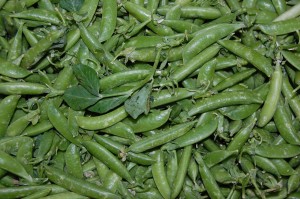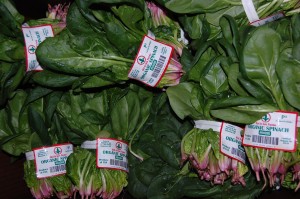Hello all and Happy Wednesday! The week is almost over, but we are enjoying every bit of this week’s produce. We’re featuring some new items this week that have been just awesome!
Today, we’d like to focus on two of Carolyn’s favorites: snap peas and spinach!
First-of-the-season sugar snap peas, these little pods are crisp and delicious. Sugar snap peas are considered to be one of the oldest crops known. Many theorists date them back to 9750 BC in Thailand and Burma. They were known to be a staple in the diet of Romans and Greeks, showing just how nutritious they are.
As they consumed as a whole, they have relatively high content of dietary fiber, vitamins K, A and B complex.
Their subtle sweet taste make them an excellent snack or a great addition to many meals. According to the blog, The Kitchn, here are 5 ways to eat these yummy little treats:
1 Snap Peas with Meyer Lemon and Mint – A quick, vibrant side dish
2 Barley Salad With Green Garlic and Snap Peas – Light yet filling – and nutritious, too!
3 Pickled Sugar Snaps – Sweet and crunchy with vinegar and garlic
4 Pork Stir-Fry with Asparagus and Sugar Snap Peas – A savory spring dinner
5 Sesame Roasted Snap Peas – Roasting brings out the sweetness of the peas
Truly a warehouse and fan favorite, along with Carolyn, spinach is back and better than ever! Spinach is one of those super food, awesome, do-all-be-all, best thing ever type of veggies. Not only is spinach amazingly healthy for you and readily available, there is literally a spinach recipe for every type of meal (breakfast to dinner and even dessert)!
So just how good is spinach for you? According to Health Diaries, there’s quite a few reasons spinach is awesome for your body:
One cup of spinach has nearly 20% of the RDA of dietary fiber, which aids in digestion, prevents constipation, maintains low blood sugar, and curbs overeating.
Cancer
Flavonoids — a phytonutrient with anti-cancer properties abundant in spinach — have been shown to slow down cell division in human stomach and skin cancer cells. Furthermore, spinach has shown significant protection against the occurrence of aggressive prostate cancer.Anti-Inflammatory
Neoxanthin and violaxanthin are two anti-inflammatory epoxyxanthophylls that play an important role in regulation of inflammation and are present in unusual amounts in spinach.Antioxidants
The vitamin C, vitamin E, beta-carotene, manganese, zinc and selenium present in spinach all serve as powerful antioxidants that combat the onset of osteoporosis, atherosclerosis and high blood pressure.Blood Pressure
By inhibiting the angiotensin I-converting enzyme, peptides within spinach have been shown to effectively lower blood pressure.Vision
Both antioxidants lutein and zeaxanthin are especially plentiful in spinach and protect the eye from cataracts and age-related macular degeneration.Immunity
One cup of spinach contains over 337% of the RDA of vitamin A that not only protects and strengthens “entry points” into the human body, such as mucous membranes, respiratory, urinary and intestinal tracts, but is also a key component of lymphocytes (or white blood cells) that fight infection.Skin
The high amount of vitamin A in spinach also promotes healthy skin by allowing for proper moisture retention in the epidermis, thus fighting psoriasis, keratinization, acne and even wrinkles.Bones
One cup of boiled spinach provides over 1000% of the RDA of vitamin K that can prevent excess activation of osteoclasts (the cells that break down bones), as well as promote the synthesis of osteocalcin, the protein that is essential for maintaining the strength and density of our bones.Brain and Nervous Function
The abundance of vitamin K in spinach contributes greatly to a healthy nervous system and brain function by providing an essential part for the synthesis of sphingolipids, the crucial fat that makes up the Myelin sheath around our nerves.






